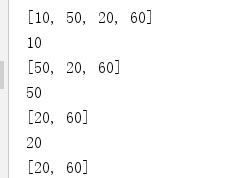您好,登錄后才能下訂單哦!
您好,登錄后才能下訂單哦!
今天要講的是ArrayBlockQueue,ArrayBlockQueue是JUC提供的線程安全的有界的阻塞隊列,一看到Array,第一反應:這貨肯定和數組有關,既然是數組,那自然是有界的了,我們先來看看ArrayBlockQueue的基本使用方法,然后再看看ArrayBlockQueue的源碼。
ArrayBlockQueue基本使用
public static void main(String[] args) throws InterruptedException {
ArrayBlockingQueue<Integer> arrayBlockingQueue=new ArrayBlockingQueue(5);
arrayBlockingQueue.offer(10);
arrayBlockingQueue.offer(50);
arrayBlockingQueue.add(20);
arrayBlockingQueue.add(60);
System.out.println(arrayBlockingQueue);
System.out.println(arrayBlockingQueue.poll());
System.out.println(arrayBlockingQueue);
System.out.println(arrayBlockingQueue.take());
System.out.println(arrayBlockingQueue);
System.out.println(arrayBlockingQueue.peek());
System.out.println(arrayBlockingQueue);
}
運行結果:

代碼比較簡單,但是你肯定會有疑問
要解決上面幾個疑問,最好的辦法當然是看下源碼,通過親自閱讀源碼所產生的印象遠遠要比看視頻,看博客,死記硬背最后的結論要深刻的多。就算真的忘記了,只要再看看源碼,瞬間可以回憶起來。
ArrayBlockQueue源碼解析
構造方法
ArrayBlockQueue提供了三個構造方法,如下圖所示:

ArrayBlockingQueue(int capacity)
public ArrayBlockingQueue(int capacity) {
this(capacity, false);
}
這是最常用的構造方法,傳入capacity,capacity是容量的意思,也就是ArrayBlockingQueue的最大長度,方法內部直接調用了第二個構造方法,傳入的第二個參數為false。
ArrayBlockingQueue(int capacity, boolean fair)
public ArrayBlockingQueue(int capacity, boolean fair) {
if (capacity <= 0)
throw new IllegalArgumentException();
this.items = new Object[capacity];
lock = new ReentrantLock(fair);
notEmpty = lock.newCondition();
notFull = lock.newCondition();
}
這個構造方法接受兩個參數,分別是capacity和fair,fair是boolean類型的,代表是公平鎖,還是非公平鎖,可以看出如果我們用第一個構造方法來創建ArrayBlockingQueue的話,采用的是非公平鎖,因為公平鎖會損失一定的性能,在沒有充足的理由的情況下,是沒有必要采用公平鎖的。
方法內部做了幾件事情:
至于排他鎖和兩個條件變量是做什么用的,看到后面就明白了。
ArrayBlockingQueue(int capacity, boolean fair,Collection<? extends E> c)
public ArrayBlockingQueue(int capacity, boolean fair,
Collection<? extends E> c) {
//調用第二個構造方法,方法內部就是初始化數組,排他鎖,兩個條件變量
this(capacity, fair);
final ReentrantLock lock = this.lock;
lock.lock(); // 開啟排他鎖
try {
int i = 0;
try {
// 循環傳入的集合,把集合中的元素賦值給items數組,其中i會自增
for (E e : c) {
checkNotNull(e);
items[i++] = e;
}
} catch (ArrayIndexOutOfBoundsException ex) {
throw new IllegalArgumentException();
}
count = i;//把i賦值給count
//如果i==capacity,也就是到了最大容量,把0賦值給putIndex,否則把i賦值給putIndex
putIndex = (i == capacity) ? 0 : i;
} finally {
lock.unlock();//釋放排他鎖
}
}
看到這里,我們應該明白這個構造方法的作用是什么了,就是把傳入的集合作為ArrayBlockingQueuede初始化數據,但是我們又會有一個新的疑問:count,putIndex 是做什么用的。
offer(E e)
public boolean offer(E e) {
checkNotNull(e);
final ReentrantLock lock = this.lock;
lock.lock();//開啟排他鎖
try {
if (count == items.length)//如果count==items.length,返回false
return false;
else {
enqueue(e);//入隊
return true;//返回true
}
} finally {
lock.unlock();//釋放鎖
}
}
看到這里,我們應該可以明白了,ArrayBlockQueue是如何保證線程安全的,還是利用了ReentrantLock排他鎖,count就是用來保存數組的當前大小的。我們再來看看enqueue方法。
private void enqueue(E x) {
final Object[] items = this.items;
items[putIndex] = x;
if (++putIndex == items.length)
putIndex = 0;
count++;
notEmpty.signal();
}
這方法比較簡單,在代碼里面就不寫注釋了,做了如下的操作:
這里就解答了一個疑問:putIndex是做什么的,就是入隊元素的下標。
add(E e)
public boolean add(E e) {
return super.add(e);
}
public boolean add(E e) {
if (offer(e))
return true;
else
throw new IllegalStateException("Queue full");
}
這個方法內部最終還是調用的offer方法。
put(E e)
public void put(E e) throws InterruptedException {
checkNotNull(e);
final ReentrantLock lock = this.lock;
lock.lockInterruptibly();//開啟響應中斷的排他鎖
try {
while (count == items.length)//如果隊列滿了,調用notFull的await
notFull.await();
enqueue(e);//入隊
} finally {
lock.unlock();//釋放排他鎖
}
}
可以看到put方法和 offer/add方法的區別了:
poll()
public E poll() {
final ReentrantLock lock = this.lock;
lock.lock();
try {
return (count == 0) ? null : dequeue();
} finally {
lock.unlock();
}
}
我們來看dequeue方法:
private E dequeue() {
final Object[] items = this.items;
@SuppressWarnings("unchecked")
E x = (E) items[takeIndex];//獲得元素的值
items[takeIndex] = null;//把null賦值給items[takeIndex]
if (++takeIndex == items.length)//如果takeIndex自增后的值== items.length,就把0賦值給takeIndex
takeIndex = 0;
count--;
if (itrs != null)
itrs.elementDequeued();
notFull.signal();//喚醒因為調用notFull的await方法而被阻塞的線程
return x;
}
這里調用了notFull的signal方法來喚醒因為調用notFull的await方法而被阻塞的線程,那到底在哪里調用了notFull的await方法呢,還記不記得在put方法中調用了notFull的await方法,我們再看看:
while (count == items.length)
notFull.await();
當隊列滿了,就調用 notFull.await()來等待,在出隊操作中,又調用了notFull.signal()來喚醒。
take()
public E take() throws InterruptedException {
final ReentrantLock lock = this.lock;
lock.lockInterruptibly();
try {
while (count == 0)
notEmpty.await();
return dequeue();
} finally {
lock.unlock();
}
}
這里調用了notEmpty的await方法,那么哪里調用了notEmpty的signal方法呢?在enqueue入隊方法里。
我們可以看到take和poll的區別:
peek()
public E peek() {
final ReentrantLock lock = this.lock;
lock.lock();
try {
return itemAt(takeIndex);
} finally {
lock.unlock();
}
}
final E itemAt(int i) {
return (E) items[i];
}
我們可以看到peek和poll/take的區別:
size()
public int size() {
final ReentrantLock lock = this.lock;
lock.lock();
try {
return count;
} finally {
lock.unlock();
}
}
總結
至此,ArrayBlockQueue的核心源碼就分析完畢了,我們來做一個總結:
以上所述是小編給大家介紹的ArrayBlockQueue源碼解析詳解整合,希望對大家有所幫助,如果大家有任何疑問請給我留言,小編會及時回復大家的。在此也非常感謝大家對億速云網站的支持!
免責聲明:本站發布的內容(圖片、視頻和文字)以原創、轉載和分享為主,文章觀點不代表本網站立場,如果涉及侵權請聯系站長郵箱:is@yisu.com進行舉報,并提供相關證據,一經查實,將立刻刪除涉嫌侵權內容。